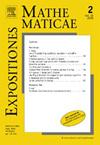Exceptional Periodicity and Magic Star algebras
IF 0.9
4区 数学
Q2 MATHEMATICS
引用次数: 0
Abstract
We introduce countably infinite series of finite dimensional generalizations of the exceptional Lie algebras: in fact, each exceptional Lie algebra (but ) is the first element of an infinite series of finite dimensional algebras, which we name Magic Star algebras. All these algebras (but the first elements of the infinite series) are not Lie algebras, but nevertheless they have remarkable similarities with many characterizing features of the exceptional Lie algebras; they also enjoy a kind of periodicity (inherited by Bott periodicity), which we name Exceptional Periodicity. We analyze the graded algebraic structures arising in a certain projection (named Magic Star projection) of the generalized root systems pertaining to Magic Star algebras, and we highlight the occurrence of a class of rank-3, Hermitian matrix (special Vinberg T)-algebras (which we call algebras) on each vertex of such a projection. We then focus on the Magic Star algebra , which generalizes the non-simply laced exceptional Lie algebra , and deserves a treatment apart. Finally, we compute the Lie algebra of the inner derivations of the algebras, pointing out the enhancements occurring for each first element of the series of Magic Star algebras, thus retrieving the result known for the derivations of cubic simple Jordan algebras.
例外周期性与幻星代数
我们引入例外李代数的有限维推广的可数无穷级数:事实上,每个例外李代数(g2除外)都是有限维代数无穷级数的第一个元素,我们将其命名为魔星代数。所有这些代数(除了无穷级数的第一个元素)都不是李代数,但是它们与特殊李代数的许多特征有显著的相似之处;它们还具有一种周期性(继承自博特周期性),我们称之为例外周期性。我们分析了属于Magic Star代数的广义根系统的某个投影(称为Magic Star投影)中产生的梯度代数结构,并强调了在该投影的每个顶点上出现的一类秩3,hermite矩阵(特殊的Vinberg T)-代数(我们称为H代数)。然后重点讨论了Magic Star代数f4(n),它推广了非单列例外李代数f4,值得单独讨论。最后,我们计算了H代数的内导的李代数,指出了Magic Star代数系列的每个第一元素的增强,从而检索了三次简单约当代数的导的已知结果。
本文章由计算机程序翻译,如有差异,请以英文原文为准。
求助全文
约1分钟内获得全文
求助全文
来源期刊
CiteScore
1.30
自引率
0.00%
发文量
41
审稿时长
40 days
期刊介绍:
Our aim is to publish papers of interest to a wide mathematical audience. Our main interest is in expository articles that make high-level research results more widely accessible. In general, material submitted should be at least at the graduate level.Main articles must be written in such a way that a graduate-level research student interested in the topic of the paper can read them profitably. When the topic is quite specialized, or the main focus is a narrow research result, the paper is probably not appropriate for this journal. Most original research articles are not suitable for this journal, unless they have particularly broad appeal.Mathematical notes can be more focused than main articles. These should not simply be short research articles, but should address a mathematical question with reasonably broad appeal. Elementary solutions of elementary problems are typically not appropriate. Neither are overly technical papers, which should best be submitted to a specialized research journal.Clarity of exposition, accuracy of details and the relevance and interest of the subject matter will be the decisive factors in our acceptance of an article for publication. Submitted papers are subject to a quick overview before entering into a more detailed review process. All published papers have been refereed.

 求助内容:
求助内容: 应助结果提醒方式:
应助结果提醒方式:


